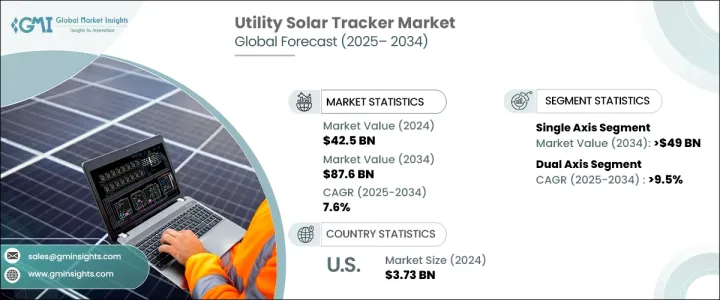PUBLISHER: Global Market Insights Inc. | PRODUCT CODE: 1716676

PUBLISHER: Global Market Insights Inc. | PRODUCT CODE: 1716676
Utility Solar Tracker Market Opportunity, Growth Drivers, Industry Trend Analysis, and Forecast 2025 - 2034
The Global Utility Solar Tracker Market reached USD 42.5 billion in 2024 and is expected to grow at a CAGR of 7.6% between 2025 and 2034. This remarkable growth trajectory is primarily fueled by the accelerating global transition toward renewable energy sources and the mounting pressure to adopt sustainable energy solutions. As governments worldwide implement stringent environmental policies and ambitious climate goals, solar energy has emerged as a leading contender in the race to decarbonize the power sector. With conventional energy costs climbing, stakeholders, including utility providers, investors, and industries, are increasingly adopting decentralized solar solutions to minimize operational costs and reduce carbon footprints.

Moreover, as the urgency to meet net-zero targets rises, the demand for high-efficiency solar infrastructure like utility-scale solar trackers is witnessing significant momentum. This is further reinforced by the ongoing advancements in solar tracking technologies that are not only enhancing the accuracy and reliability of energy capture but also optimizing long-term returns on solar investments. Additionally, growing public-private partnerships, incentives for solar deployment, and increasing investments in grid modernization are setting the stage for a robust market expansion. The utility solar tracker market is evolving rapidly to accommodate both large-scale and distributed solar applications, thereby supporting a more resilient and flexible energy landscape.
| Market Scope | |
|---|---|
| Start Year | 2024 |
| Forecast Year | 2025-2034 |
| Start Value | $42.5 Billion |
| Forecast Value | $87.6 Billion |
| CAGR | 7.6% |
As the cost of solar technologies continues to decline, the adoption of advanced solar trackers is expanding across various regions. Stakeholders are leveraging these cost reductions to deploy solar tracker systems that significantly improve the performance and output of solar installations. Solar trackers are proving to be a critical component in maximizing energy generation, especially in regions with varying solar irradiance. The rising efficiency of solar systems combined with the escalating cost of traditional energy is encouraging utilities and independent producers to opt for trackers that offer optimal sun exposure throughout the day. The market is also witnessing a shift toward decentralized power generation, with solar trackers playing a key role in boosting the output of distributed solar arrays and enhancing grid stability.
The market is segmented into single-axis and dual-axis solar trackers. The single-axis tracker segment generated USD 42.5 billion in 2024 and is projected to reach USD 49 billion by 2034. Innovations in this segment, including enhanced control systems and integration of smart technologies, are making solar trackers more precise and efficient. These improvements help maximize sunlight capture and increase energy output, contributing to greater returns on investment. On the other hand, dual-axis trackers, capable of adjusting both azimuth and elevation angles, are becoming increasingly popular for their superior tracking capabilities and higher energy yields. With a projected CAGR of 9.5% through 2034, dual-axis trackers are gaining traction in space-constrained environments such as industrial plants and urban areas where maximizing energy production is crucial. Their ability to follow the sun's path throughout the day makes them ideal for locations where every additional unit of energy counts.
Europe Utility Solar Tracker Market is expected to generate USD 10 billion by 2034, driven by growing demand for energy-efficient systems and rising investments in solar heating and advanced photovoltaic technologies. European nations are ramping up investments in solar to meet clean energy targets, pushing forward innovations that enhance the performance and efficiency of solar tracking systems across the region.
Table of Contents
Chapter 1 Methodology & Scope
- 1.1 Research design
- 1.2 Base estimates & calculations
- 1.3 Forecast model
- 1.4 Primary research & validation
- 1.4.1 Primary sources
- 1.4.2 Data mining sources
- 1.5 Market definitions
Chapter 2 Executive Summary
- 2.1 Industry synopsis, 2021 – 2034
Chapter 3 Industry Insights
- 3.1 Industry ecosystem
- 3.2 Regulatory landscape
- 3.3 Industry impact forces
- 3.3.1 Growth drivers
- 3.3.2 Industry pitfalls & challenges
- 3.4 Growth potential analysis
- 3.5 Price trend analysis
- 3.6 Porter's analysis
- 3.6.1 Bargaining power of suppliers
- 3.6.2 Bargaining power of buyers
- 3.6.3 Threat of new entrants
- 3.6.4 Threat of substitutes
- 3.7 PESTEL analysis
Chapter 4 Competitive landscape, 2024
- 4.1 Introduction
- 4.2 Strategic dashboard
- 4.3 Innovation & technology landscape
Chapter 5 Market Size and Forecast, By Product, 2021 – 2034 (USD Billion & MW)
- 5.1 Key trends
- 5.2 Single axis
- 5.3 Dual axis
Chapter 6 Market Size and Forecast, By Region, 2021 – 2034 (USD Billion & MW)
- 6.1 Key trends
- 6.2 North America
- 6.2.1 U.S.
- 6.2.2 Canada
- 6.2.3 Mexico
- 6.3 Europe
- 6.3.1 UK
- 6.3.2 France
- 6.3.3 Netherlands
- 6.3.4 Germany
- 6.3.5 Sweden
- 6.3.6 Spain
- 6.3.7 Austria
- 6.4 Asia Pacific
- 6.4.1 China
- 6.4.2 Japan
- 6.4.3 South Korea
- 6.4.4 India
- 6.4.5 Australia
- 6.5 Middle East
- 6.5.1 Saudi Arabia
- 6.5.2 UAE
- 6.5.3 Jordan
- 6.5.4 Israel
- 6.6 Africa
- 6.6.1 South Africa
- 6.6.2 Egypt
- 6.6.3 Algeria
- 6.6.4 Nigeria
- 6.6.5 Morocco
- 6.7 Latin America
- 6.7.1 Brazil
- 6.7.2 Chile
Chapter 7 Company Profiles
- 7.1 Antai Technologies
- 7.2 Arctech
- 7.3 Array Technologies
- 7.4 FTC Solar
- 7.5 GameChange Solar
- 7.6 Mecasolar
- 7.7 NCLAVE
- 7.8 Nextracker
- 7.9 PVHardware
- 7.10 Scorpius Trackers
- 7.11 SOLTEC
- 7.12 STI Norland
- 7.13 Trina Solar




